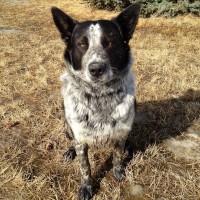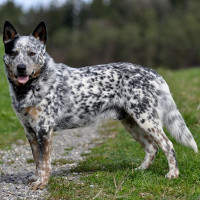Appearance of the Border Heeler
|
| The appearance of the Border Heeler may reflect traits that have contributed to the biological gene pool of one or both of its parent breeds. Most seem to inherit blue or red flecking or mottling from the Australian Cattle Dog parent and a combined coat type from the Border Collie parent. Both parent breeds have solid, sturdy, compact bodies that are slightly longer than they are tall, and both are approximately the same height and weight. The skull is strong and proportionate to the rest of the body. The eyes are oval, moderately sized and brown or any color, and both may vary in color with an alert expression. Ears may be medium-sized, broad at the base, pricked and pointed, or medium-sized, erect or semi-erect with points falling forward or outward to the side. The muzzle and nose will be strong and of medium length, with tight lips and scissor-like teeth and powerful, well developed jaws. The paws may be round with short, well arched toes that are close together with hard, deep pads and short, strong nails, or they may be compact, oval-shaped with solid, deep pads and moderately arched toes that are close together and have moderately long, strong nails. Your Border Heeler's tail may be low and have a slight curl. It may have a double coat with a short, dense undercoat, the outer coat being short or medium with stiff or slightly wavy weather-resistant hairs. Your Border Heeler can be virtually any color, with blue or red patches or markings. |
Temperament of the Border Heeler
|
| Your Border Heeler is a hybrid created from crossing the Border Collie and the Australian Cattle Dog and, as such, can take on the temperament of one or both parent breeds. Your pet could therefore be aggressive, alert, energetic, intelligent, loyal, protective and reactive. He'll be sensitive and his barking tendencies could range from occasional to frequent. He may be in the moderate to considerable range of playful biting, with a moderate hunting drive and a tendency to wander. Your Border Heeler will be good with children and relatively good with strangers and other dogs and cats. The level of intelligence provided by both parent breeds is simply incredible and, that said, it's important to note that this hybrid will need to be mentally and physically maintained to avoid the boredom and unacceptable behaviors that can accompany this condition. He's a high-energy dog who has been bred to work hard and help his owners, so it would be a good idea to allow him to help you with your daily activities as much as possible. Don't be surprised if he guards children, other animals in your home or even around the neighborhood. Owners of this hybrid have described the ease of training as similar to giving instructions to a child. |
Needs and activities of the Border Heeler
|
| Your Border Heeler is a hybrid created from the Border Collie and the Australian Cattle Dog. These two parent breeds are high-energy canines that have been bred for breeding and hard work. They will need to remain active and challenged, mentally and physically, to avoid boredom and the unacceptable destructive behaviors that can accompany boredom. This is not a dog that can be subjected to the limitations of apartment living. He'll do much better in a family home with a fenced-in yard and plenty of opportunities for exercise and physical and mental challenge. Daily walks lasting 1-2 hours, games of fetch, Frisbee or soccer will help keep him busy so he doesn't start guarding dogs, cats, children and people. He'll do well in urban or rural environments as long as there's ample opportunity for exercise. Cooler climates suit him best, as he's equipped with a dense, weather-resistant coat. |
Maintenance of the Border Heeler
|
| The Border Heeler will require some grooming maintenance, which will vary from low to moderate, depending on which parent breed has the most influence in the gene pool. He'll need brushing once or twice a week to reduce the natural shedding that takes place with both parent breeds, but he won't need bathing and shampooing unless necessary. Frequent bathing will reduce the oil in the coat, which contributes to the coat's weather resistance. As with most canine breeds, attention to proper ear examination and cleaning to prevent ear infections and regular eye examinations to assess and monitor the variety of eye problems that afflict parent breeds. Most canine breeds require regular, routine dental examinations and teeth cleaning to prevent periodontal disease and tooth loss. |









 English (United Kingdom)
English (United Kingdom)